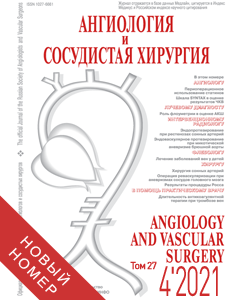Journal «Angiology and Vascular Surgery» •
2009 • VOLUME 15 • №3
Surgical and endovascular treatment of floating thromboses in the system of the inferior vena cava
Ignatiev I.M., Akchurin F.R., Zanochkin A.V., Volodyukhin M.Yu., Bredikhin R.A.
Federal Facility Interregional Clinical and Diagnostic Centre Course of Cardiovascular Surgery of the Kazan State Medical University Kazan, Russia
In order to work out the indications for surgical and endovascular treatment of floating thromboses in the system of the inferior vena cava (IVC) and to evaluate the therapeutic outcomes obtained we examined a total of one hundred and forty-five 17-to-85-year-old patients presenting with acute thrombosis in the system of the IVC. Of these, floating thromboses were revealed in ninety-five patients. The most frequently encountered localization of the floating thrombus was the common femoral vein (CFV). In 77 patients, thrombosis originated from the femoral vein (FV), and in 12 instances – from the saphenofemoral junction. The signs of pulmonary thromboembolism (PTE) were diagnosed in 22 cases.
Instrumental studies included ultrasonographic duplex scanning (USDS), roentgenopaque and computer-assisted phlebography, and perfusion-mediated scintigraphy of the lungs.
Thrombectomy from the common iliac vein (CIV), external iliac vein (EIV) and common femoral vein (CFV) with resection of the femoral vein was performed in forty-seven patients; of these, the procedure was combined with establishing a temporal proximal arteriovenous fistula (AVF) in sixteen subjects. The femoral vein was resected in nineteen instances. Thrombectomy form the IVC with the help of the «TREKS» device was carried out in six patients. Cava filters were implanted in a total of eighty-four patients. Of these, ten devices were intended and had to be 3 left for permanent implantation, with the remaining seventy-four patients having received retrievable ones.
Rethromboses in the early postoperative period were observed to occur in four patients. The patients with the AVFs applied had no thromboses. PTE occurred in four patients, with one lethal outcome. Another patient died due to myocardial infarction. Temporary cava filters were successfully retrieved in sixty-eight patients within the terms from 10 to 56 postoperative days long-term results up to 2 years were followed up for thirtyeight patients, with good outcomes noted in twenty-six cases, satisfactory in ten, and poor results seen in two patients.
An active therapeutic policy pursued in management of floating embolus-hazardous thromboses is the only efficient measure making it possible to reliably prevent the development of both PTE and post-thrombotic disease.
KEY WORDS: floating venous thromboses, ultrasonographic angioscanning, thrombectomy, arteriovenous fistula, resection of the femoral vein, cava filter, pulmonary thromboembolism.
P. 62
ARCHIVES MAGAZINE
2021 (Vol.27)
2020 (Vol.26)
2019 (Vol.25)
2018 (Vol.24)
2017 (Vol.23)
2016 (Vol.22)
2015 (Vol.21)
2014 (Vol.20)
2013 (Vol.19)
2012 (Vol.18)
2011 (Vol.17)
2010 (Vol.16)
2009 (Vol.15)
2008 (Vol.14)
2007 (Vol.13)
2006 (Vol.12)
2005 (Vol.11)
2004 (Vol.10)
2001 (Vol.7)
2000 (Vol.6)
1999 (Vol.5)
1998 (Vol.4)
1997 (Vol.3)


